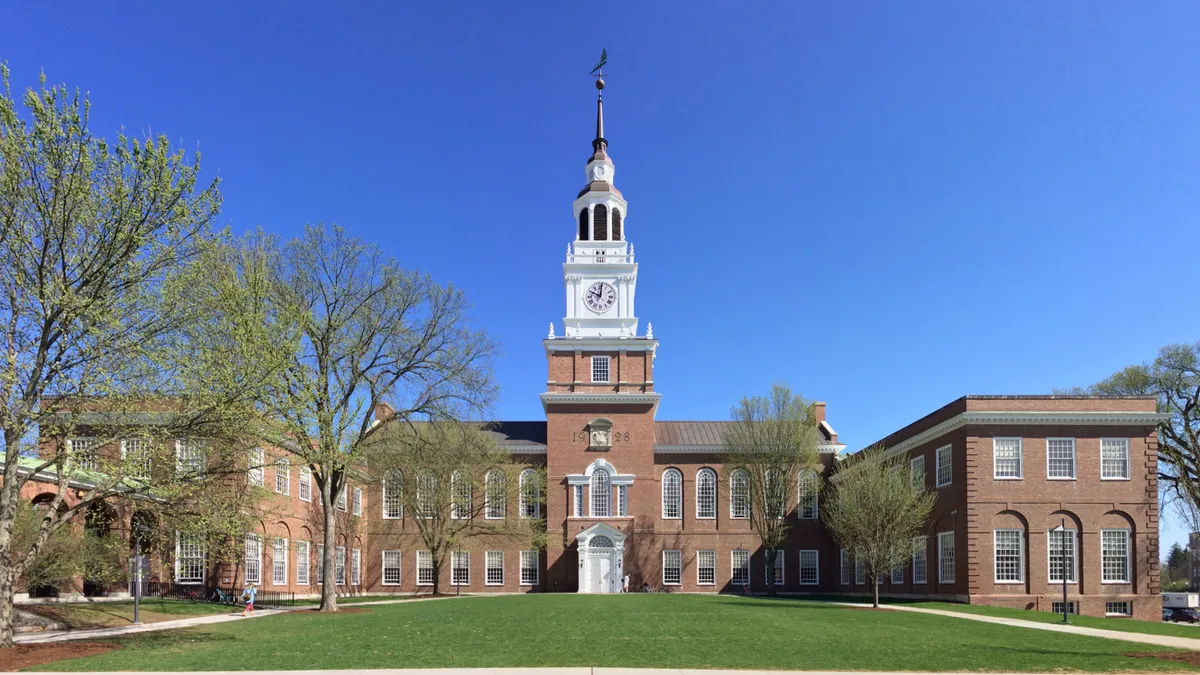It's been nearly seven months since Congress passed the only major coronavirus aid legislation yet, the Coronavirus Aid, Relief and Economic Security (CARES) Act. Since then, lawmakers have introduced several proposals, but none have found bipartisan agreement.
The deadlock has left postsecondary institutions floundering as their budgets take a hit from the combination of decreased enrollment, lost auxiliary revenue and state budget cuts.
That's not to say the CARES Act was perfect. The U.S. Department of Education complicated its implementation with guidance industry officials deemed vague and perplexing. In particular, the agency restricted emergency CARES grants to those who were eligible for federal financial aid, excluding international and other noncitizen students.
More money is needed for colleges to blunt the pandemic's fallout, higher ed groups say. But whether that's coming, and how much they will get, is uncertain.
Here, we take a look at the current and future postsecondary relief.
What has been approved?
President Donald Trump signed the $2 trillion CARES Act into law in March. It designates about $14 billion for higher education, the majority of which is split into two buckets: roughly $6 billion for institutions to defray pandemic-related expenses, and $6 billion for colleges to pass to students as emergency grants.
The top higher education lobby, the American Council on Education, slammed the higher ed allocations, calling them "woefully inadequate."
Colleges have also benefited from funding given to state governments in other parts of the CARES Act, including a $3 billion fund to help states stabilize their education programs.
Additionally, according to an Education Dive analysis, more than 670 nonprofit institutions, and at least 100 other postsecondary entities, have benefitted from the new Paycheck Protection Program, which helps keep small businesses' employees on the payroll.
What has been proposed?
Congress has debated several relief measures since passing the CARES Act.
In May, House Democrats approved a $3 trillion aid package, known as the Health and Economic Recovery Omnibus Emergency Solutions (HEROES) Act. The plan set aside $37 billion for higher ed. But it was immediately discarded by Senate Republicans, who felt it was overreaching.
In an attempt to revive negotiations, the House passed a revised version of the HEROES Act this month, which upped higher ed's allocation to $39 billion.
But talks were hamstrung further after Trump earlier this month demanded Treasury Secretary Steven Mnuchin stop working with House Speaker Nancy Pelosi. Trump has since backed down, and Mnuchin and Pelosi continue to meet, though no deal has emerged.
The Senate's proposals also haven't gone anywhere.
Republicans offered the $1 trillion Health, Economic Assistance, Liability Protection and Schools (HEALS) Act in July, which pegged $29 billion in direct support to colleges and universities. Democratic senators tried a pie-in-the-sky approach in June with a $430 billion bill to address child care and educational needs, which reserved $132 billion for higher ed.
How much is the sector asking for?
ACE told Congressional leaders that higher ed needs at least $120 billion in the next aid bill. It reiterated that request in a recent letter, citing state budget shortfalls in the hundreds of millions of dollars. ACE asked for at least $47 billion earlier in the pandemic.
Will higher ed get more relief money by the Nov. 3 election?
Probably not, said Jonathan Fansmith, ACE's director of government relations. Institutions should prepare for that, he said. An agreement could come out of the lame-duck session, Fansmith said, but some lawmakers may be unwilling to budge if they don't feel there's political gain.
"There is a real urgent need that the administration does not understand," Fansmith said.
What is going on with CARES Act money?
Colleges have claimed quite a bit of it.
As of Oct. 19, they had drawn down $5.6 billion of the $6.2 billion for student grants, and $3.6 billion of a similar amount earmarked for institutional costs, according to Education Department spokesperson Angela Morabito.
CARES funding can't go to colleges that offered only distance education courses before the pandemic. Also, some institutions that were provided CARES dollars, including Harvard, Yale and Princeton universities, rejected them after Trump and Education Secretary Betsy DeVos said wealthy institutions shouldn't benefit.
Policy wonks criticized the department for urging colleges to forgo funding despite not having a mechanism in place to redistribute the money.
Morabito did not answer an emailed question about whether the department has since developed a method for redistributing unclaimed money to other colleges.
Are there still limits on which students can receive CARES emergency grants?
Yes. After backlash over its restrictions, the department issued an emergency rule solidifying that the money can only go to those who qualify for Title IV aid.
The rule has been subject to several legal challenges, however, some of which carved out exceptions. Massachusetts schools and California's community colleges are exempt from the regulation entirely after they won injunctions against the department.
A narrower ruling in Washington state allowed colleges there to distribute grants to all students who are U.S. citizens.
Can colleges be punished for giving noncitizens aid?
Not retroactively. The department made clear in its rule that colleges that distributed grants to excluded populations before the rule was published won't be disciplined.
How have the department's restrictions on who can receive emergency CARES grants affected colleges?
Institutions must do a bit more work. They need students to prove they're Title IV eligible. The easiest way of accomplishing that is if students complete a Free Application for Federal Student Aid, or FAFSA, and so that's what most institutions are requiring, said Clare McCann, deputy director for federal higher ed policy at left-aligned think tank New America.
Not every student has a FAFSA on file, though, and the deadlines to file them vary. That could bar some students from grants, such as veterans, who are less likely to have filed a FAFSA in part because they get other forms of federal aid.
What about the other half of the CARES money? What can colleges spend that on?
Colleges can't use their cut of the $6 billion in institutional CARES funds to make up for lost revenue generally, according to the department. But there's still some confusion over what counts.
In an agency webinar earlier this month, Diane Auer Jones, principal deputy under secretary, apologized to institutions, saying "it is possible that you've gotten some inconsistent answers," when the department gave advice to colleges about the funds. Auer Jones blamed the need to move quickly to distribute the money.
The "key" to proving an expense can be covered, Auer Jones said, is that it is connected to something like a bill or invoice that arose from the virus disrupting instruction, which can be broadly interpreted.
An example: If an institution hired instructors to reduce class sizes in compliance with social distancing, it could use CARES money to pay for the new faculty members' salaries. However, it could not use the funds to pay those who were hired pre-pandemic. Other uses could include paying for part of a housing utility bill, if an institution changed its residential density because of the virus.
The recent FAQ offers more details on expenses colleges can pay for with institutional CARES funding. It also notes that the department can reclaim institutional funds that aren't used within a year of when they were issued.
Are there reporting requirements for CARES funding?
Yes. Colleges must publicly report on their websites how they used their funding. The next report on student grant funding is due by Jan. 10, 2021. The next report for the institutional money is due by Oct. 30 of this year. More information on reporting deadlines can be found here.
What's next?
Institutions will likely have more questions about CARES funding, even with the department's continued clarifications, McCann said. What colleges can spend CARES dollars on remains somewhat muddied, though costs such as new technology and cleaning supplies "are a pretty safe bet," she said.
Some institutions and pundits have taken issue with the way relief funding was calculated in the CARES Act. Colleges' portions were based on their full-time enrollment, heavily weighted toward how many students get the federal Pell Grant. But community colleges heavily enroll part-time students, many of whom are low-income or otherwise disadvantaged. This means two-year schools missed out on assistance, McCann said.
Public two-year schools are suffering, with fall enrollment down more than 9% year-over-year, according to the latest data. That's compared to a 4% decrease for the sector overall.
The HEROES Act remedies this, as its formula uses total enrollment.



















